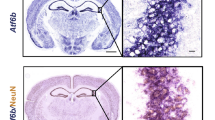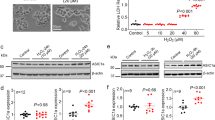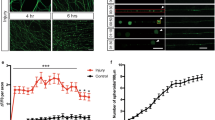Abstract
Excitotoxic neuronal death contributes to many neurological disorders, and involves calcium influx and stress-activated protein kinases (SAPKs) such as p38α. There is indirect evidence that the small Rho-family GTPases Rac and cdc42 are involved in neuronal death subsequent to the withdrawal of nerve growth factor (NGF), whereas Rho is involved in the inhibition of neurite regeneration and the release of the amyloidogenic Aβ42 peptide. Here we show that Rho is activated in rat neurons by conditions that elevate intracellular calcium and in the mouse cerebral cortex during ischemia. Rho is required for the rapid glutamate-induced activation of p38α and ensuing neuronal death. The ability of RhoA to activate p38α was not expected, and it was specific to primary neuronal cultures. The expression of active RhoA alone not only activated p38α but also induced neuronal death that was sensitive to the anti-apoptotic protein Bcl-2, showing that RhoA was sufficient to induce the excitotoxic pathway. Therefore, Rho is an essential component of the excitotoxic cell death pathway.
This is a preview of subscription content, access via your institution
Access options
Subscribe to this journal
Receive 12 print issues and online access
$209.00 per year
only $17.42 per issue
Buy this article
- Purchase on Springer Link
- Instant access to full article PDF
Prices may be subject to local taxes which are calculated during checkout








Similar content being viewed by others
References
Palmer, G.C. & Widzowski, D. Low affinity use-dependent NMDA receptor antagonists show promise for clinical development. Amino Acids 19, 151–155 (2000).
Kawasaki, H. et al. Activation and involvement of p38 mitogen-activated protein kinase in glutamate-induced apoptosis in rat cerebellar granule cells. J. Biol. Chem. 272, 18518–18521 (1997).
Borsello, T. et al. A peptide inhibitor of c-Jun N-terminal kinase protects against excitotoxicity and cerebral ischemia. Nat. Med. 9, 1180–1186 (2003).
Cao, J. et al. Distinct requirements for p38α and JNK stress-activated protein kinases in different forms of apoptotic neuronal death. J. Biol. Chem. 279, 35903–35913 (2004).
Coffey, E.T., Hongisto, V., Dickens, M., Davis, R.J. & Courtney, M.J. Dual roles for JNK in developmental and stress responses in cerebellar granule neurons. J. Neurosci. 20, 7602–7613 (2000).
Björkblom, B. et al. Constitutively active cytoplasmic c-Jun N-terminal kinase 1 is a dominant regulator of dendritic architecture: role of microtubule-associated protein 2 as an effector. J. Neurosci. 25, 6350–6361 (2005).
Tararuk, T. et al. JNK1 phosphorylation of SCG10 determines microtubule dynamics and axodendritic length. J. Cell Biol. 173, 265–277 (2006).
Bazenet, C.E., Mota, M.A. & Rubin, L.L. The small GTP-binding protein Cdc42 is required for nerve growth factor withdrawal-induced neuronal death. Proc. Natl. Acad. Sci. USA 95, 3984–3989 (1998).
Linseman, D.A. et al. An essential role for Rac/Cdc42 GTPases in cerebellar granule neuron survival. J. Biol. Chem. 276, 39123–39131 (2001).
Marinissen, M.J., Chiariello, M. & Gutkind, J.S. Regulation of gene expression by the small GTPase Rho through the ERK6 (p38 gamma) MAP kinase pathway. Genes Dev. 15, 535–553 (2001).
Ramakers, G.J. Rho proteins, mental retardation and the cellular basis of cognition. Trends Neurosci. 25, 191–199 (2002).
Lehmann, M. et al. Inactivation of Rho signaling pathway promotes CNS axon regeneration. J. Neurosci. 19, 7537–7547 (1999).
Schwab, M.E. Nogo and axon regeneration. Curr. Opin. Neurobiol. 14, 118–124 (2004).
Zhou, Y. et al. Nonsteroidal anti-inflammatory drugs can lower amyloidogenic Aβ42 by inhibiting Rho. Science 302, 1215–1217 (2003).
Li, Z., Aizenman, C.D. & Cline, H.T. Regulation of rho GTPases by crosstalk and neuronal activity in vivo. Neuron 33, 741–750 (2002).
Benink, H.A. & Bement, W.M. Concentric zones of active RhoA and Cdc42 around single cell wounds. J. Cell Biol. 168, 429–439 (2005).
Wilde, C., Genth, H., Aktories, K. & Just, I. Recognition of RhoA by Clostridium botulinum C3 exoenzyme. J. Biol. Chem. 275, 16478–16483 (2000).
Karnoub, A.E., Symons, M., Campbell, S.L. & Der, C.J. Molecular basis for Rho GTPase signaling specificity. Breast Cancer Res. Treat. 84, 61–71 (2004).
Ren, X.D., Kiosses, W.B. & Schwartz, M.A. Regulation of the small GTP-binding protein Rho by cell adhesion and the cytoskeleton. EMBO J. 18, 578–585 (1999).
Kjoller, L. & Hall, A. Signaling to Rho GTPases. Exp. Cell Res. 253, 166–179 (1999).
Sander, E.E. et al. Matrix-dependent Tiam1/Rac signaling in epithelial cells promotes either cell-cell adhesion or cell migration and is regulated by phosphatidylinositol 3-kinase. J. Cell Biol. 143, 1385–1398 (1998).
Yoshizaki, H. et al. Activity of Rho-family GTPases during cell division as visualized with FRET-based probes. J. Cell Biol. 162, 223–232 (2003).
Reid, T. et al. Rhotekin, a new putative target for Rho bearing homology to a serine/threonine kinase, PKN, and rhophilin in the rho-binding domain. J. Biol. Chem. 271, 13556–13560 (1996).
Wennerberg, K. et al. RhoG signals in parallel with Rac1 and Cdc42. J. Biol. Chem. 277, 47810–47817 (2002).
Genth, H. et al. Entrapment of Rho ADP-ribosylated by Clostridium botulinum C3 exoenzyme in the Rho-guanine nucleotide dissociation inhibitor-1 complex. J. Biol. Chem. 278, 28523–28527 (2003).
Courtney, M.J., Lambert, J.J. & Nicholls, D.G. The interactions between plasma membrane depolarization and glutamate receptor activation in the regulation of cytoplasmic free calcium in cultured cerebellar granule cells. J. Neurosci. 10, 3873–3879 (1990).
Chen, J.C., Zhuang, S., Nguyen, T.H., Boss, G.R. & Pilz, R.B. Oncogenic Ras leads to Rho activation by activating the mitogen-activated protein kinase pathway and decreasing Rho-GTPase-activating protein activity. J. Biol. Chem. 278, 2807–2818 (2003).
Hart, M.J. et al. Direct stimulation of the guanine nucleotide exchange activity of p115 RhoGEF by Gα13. Science 280, 2112–2114 (1998).
Nakazawa, T. et al. p250GAP, a novel brain-enriched GTPase-activating protein for Rho family GTPases, is involved in the N-methyl-d-aspartate receptor signaling. Mol. Biol. Cell 14, 2921–2934 (2003).
Gallagher, E.D., Gutowski, S., Sternweis, P.C. & Cobb, M.H. RhoA binds to the amino terminus of MEKK1 and regulates its kinase activity. J. Biol. Chem. 279, 1872–1877 (2004).
Zong, H., Raman, N., Mickelson-Young, L.A., Atkinson, S.J. & Quilliam, L.A. Loop 6 of RhoA confers specificity for effector binding, stress fiber formation, and cellular transformation. J. Biol. Chem. 274, 4551–4560 (1999).
Ishizaki, T. et al. Pharmacological properties of Y-27632, a specific inhibitor of rho-associated kinases. Mol. Pharmacol. 57, 976–983 (2000).
Arakawa, Y. et al. Control of axon elongation via an SDF-1α/Rho/mDia pathway in cultured cerebellar granule neurons. J. Cell Biol. 161, 381–391 (2003).
Marinissen, M.J. et al. The small GTP-binding protein RhoA regulates c-jun by a ROCK-JNK signaling axis. Mol. Cell 14, 29–41 (2004).
Coffey, E.T. et al. JNK2/3 is specifically activated by stress, mediating c-jun activation, in the presence of constitutive JNK1 activity in cerebellar neurons. J. Neurosci. 22, 4335–4345 (2002).
Jeon, S. et al. RhoA and Rho kinase-dependent phosphorylation of moesin at Thr-558 in hippocampal neuronal cells by glutamate. J. Biol. Chem. 277, 16576–16584 (2002).
Sattler, R., Xiong, Z., Lu, W.Y., MacDonald, J.F. & Tymianski, M. Distinct roles of synaptic and extrasynaptic NMDA receptors in excitotoxicity. J. Neurosci. 20, 22–33 (2000).
Chalecka-Franaszek, E. & Chuang, D.M. Lithium activates the serine/threonine kinase Akt-1 and suppresses glutamate-induced inhibition of Akt-1 activity in neurons. Proc. Natl. Acad. Sci. USA 96, 8745–8750 (1999).
Didenko, V.V. et al. Caspase-3-dependent and -independent apoptosis in focal brain ischemia. Mol. Med. 8, 347–352 (2002).
Fukuda, T., Wang, H., Nakanishi, H., Yamamoto, K. & Kosaka, T. Novel non-apoptotic morphological changes in neurons of the mouse hippocampus following transient hypoxic-ischemia. Neurosci. Res. 33, 49–55 (1999).
Yu, S.W., Wang, H., Dawson, T.M. & Dawson, V.L. Poly(ADP-ribose) polymerase-1 and apoptosis inducing factor in neurotoxicity. Neurobiol. Dis. 14, 303–317 (2003).
Sohn, S., Kim, E.Y. & Gwag, B.J. Glutamate neurotoxicity in mouse cortical neurons: atypical necrosis with DNA ladders and chromatin condensation. Neurosci. Lett. 240, 147–150 (1998).
Csernansky, C.A., Canzoniero, L.M., Sensi, S.L., Yu, S.P. & Choi, D.W. Delayed application of aurintricarboxylic acid reduces glutamate-induced cortical neuronal injury. J. Neurosci. Res. 38, 101–108 (1994).
Lobner, D. & Choi, D.W. Preincubation with protein synthesis inhibitors protects cortical neurons against oxygen-glucose deprivation-induced death. Neuroscience 72, 335–341 (1996).
Gwag, B.J. et al. Slowly triggered excitotoxicity occurs by necrosis in cortical cultures. Neuroscience 77, 393–401 (1997).
Legos, J.J. et al. SB 239063, a novel p38 inhibitor, attenuates early neuronal injury following ischemia. Brain Res. 892, 70–77 (2001).
Dawson, V.L., Kizushi, V.M., Huang, P.L., Snyder, S.H. & Dawson, T.M. Resistance to neurotoxicity in cortical cultures from neuronal nitric oxide synthase-deficient mice. J. Neurosci. 16, 2479–2487 (1996).
Huang, Z. et al. Effects of cerebral ischemia in mice deficient in neuronal nitric oxide synthase. Science 265, 1883–1885 (1994).
Nagai, T., Yamada, S., Tominaga, T., Ichikawa, M. & Miyawaki, A. Expanded dynamic range of fluorescent indicators for Ca(2+) by circularly permuted yellow fluorescent proteins. Proc. Natl. Acad. Sci. USA 101, 10554–10559 (2004).
Courtney, M.J., Åkerman, K.E. & Coffey, E.T. Neurotrophins protect cultured cerebellar granule neurons against the early phase of cell death by a two-component mechanism. J. Neurosci. 17, 4201–4211 (1997).
Acknowledgements
We thank M. Matsuda (University of Tokyo), B.J. Mayer (University of Connecticut Health Center), A. Miyawaki, L.A. Quilliam (Indiana University School of Medicine), J.M. Kyriakis (Tufts University School of Medicine), A. Hall (University College London), S. van den Heuvel (Massachusetts General Hospital Cancer Center), T. Wieland (Universitätsklinikum Hamburg-Eppendorf), M. Negishi (US National Institute of Environmental Health Sciences), H.A. Singer (Albany Medical College), M. Jäättelä (Danish Cancer Society) and J. Ellenberg (European Molecular Biology Laboratory) for providing plasmids used in this study. This work was funded by grants from the Academy of Finland (grants 72446, 78232, 203520, 206903 and 110445), the EU 6th Framework programme, the AIVI graduate school, the K. Albin Johansson Foundation and the University of Kuopio. M.J.C. is an Academy of Finland researcher.
Author information
Authors and Affiliations
Contributions
All authors conducted experiments for this work and M.J.C. also wrote the manuscript.
Corresponding author
Ethics declarations
Competing interests
The authors declare no competing financial interests.
Supplementary information
Supplementary Fig. 1
Glutamate-induced calcium increase is not reduced by C3 exoenzyme treatment. (PDF 101 kb)
Supplementary Fig. 2
Glutamate leads to a slow reduction of GTP-loaded Rac1. (PDF 101 kb)
Supplementary Fig. 3
Activation of the p38 pathway induces neuronal pyknosis. (PDF 85 kb)
Supplementary Fig. 4
p115RhoGEF and CamKII pathways are not responisble for glutamate-evoked Rho activation and pyknosis. (PDF 150 kb)
Supplementary Fig. 5
Rho-dependent pyknosis requires the effector-interacting sequences in Rho loop6. (PDF 79 kb)
Supplementary Fig. 6
Scheme depicting the proposed role of Rho in regulation of p38α by glutamate. (PDF 80 kb)
Supplementary Table 1
The number of cell used in all cell counting and single cell FRET assays is shown for all figures. (PDF 9 kb)
Rights and permissions
About this article
Cite this article
Semenova, M., Mäki-Hokkonen, A., Cao, J. et al. Rho mediates calcium-dependent activation of p38α and subsequent excitotoxic cell death. Nat Neurosci 10, 436–443 (2007). https://doi.org/10.1038/nn1869
Received:
Accepted:
Published:
Issue Date:
DOI: https://doi.org/10.1038/nn1869
This article is cited by
-
Resonance energy transfer sensitises and monitors in situ switching of LOV2-based optogenetic actuators
Nature Communications (2020)
-
Targeting NMDA receptors in stroke: new hope in neuroprotection
Molecular Brain (2018)
-
A simple optogenetic MAPK inhibitor design reveals resonance between transcription-regulating circuitry and temporally-encoded inputs
Nature Communications (2017)
-
The beneficial effects of HMG-CoA reductase inhibitors in the processes of neurodegeneration
Metabolic Brain Disease (2017)
-
RhoA/Rho Kinase Mediates Neuronal Death Through Regulating cPLA2 Activation
Molecular Neurobiology (2017)



